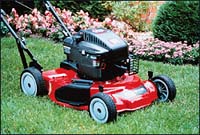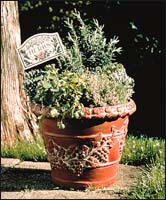Butterflies may not know it but
they have a best friend in David Liebman.
As a wildlife photographer, David captures butterflies in every stage of their lives
— eggs, larva (caterpillar), pupa (chrysalid) and adult.
More Diggin' In |
CATCH KATHY!
See "Diggin’ in" at 12:57 and 8:56 p.m. Saturdays and 8:56 p.m.
Thursdays on WHRO TV 15, brought to you by McDonald Garden Center.Make a hat for Kathy
to wear on one of the segments and win a $20 gift certificate to McDonald Garden Center
and a pair of passes to Norfolk Botanical Garden.
WHRV-FM’s Hear/Say noon-1 p.m. Aug. 17.
Read the "Diggin' In" column from Sunday's
Daily Press.
Hear Kathy’s gardening tips on the 1-Line anytime:
757-928-1111, category 4769 (GROW).
The gardening trivia contest takes summer vacation, returning in
September.
Post your gardening tips on our message boards
to be eligible for giveaways.
|
But he goes one step further — he raises many of these butterflies from egg to
adulthood. And he cultivates many of the host and nectar plants needed to attract
different species of butterflies.
David's home in one of the older neighborhoods of Norfolk is actually a working
laboratory. Outdoors, the entire yard — no fine fescue lawn here — is covered
with plants that can become the stars of some subject he is working on.
His yard, however, is not his only laboratory. For years, he's been planting
butterfly-attracting plants along our roadways.
"My places can be within the city, along the interstate in neighboring cities or
even along the edges of the Dismal Swamp on Route 58," says David.
You can be riding along in your car and see David's work — a sleeve from a shirt,
a piece of nylon hosiery or a length of cheese cloth tied around a tree branch to protect
some delicate butterfly larva that otherwise may become dinner for a paper wasp.
I call him Hampton Roads' secret gardener. More of us should be like him, helping our
wildlife continue to exist in the threat of developing neighborhoods and industrial parks.
"I have been planting butterfly and moth food plants along woods and in fields for
more than 30 years," says David. "Some of the city grass cutting services know
where they are, so they don't cut them."
Like so many of us who fret over the disappearance of wetlands, meadows and forests,
David agrees "we are the problem."
For example, he says, each fall monarchs face a shortage of nectar plants to give them
the energy to fly back to Mexico where they spend the winter.
"Mankind has destroyed the habitat containing milkweed as well as fall flowering
plants in the name of progress," he says. "Someday the monarch may only be seen
in museums as is the passenger pigeon. Of the hundreds of millions of passenger pigeons
that once flourished on the East Coast, only two are on exhibit at the Smithsonian in
Washington."
With David around doing his good deeds, maybe the monarch and other butterflies will
continue to entertain us with their rainbow colors and fluttering gymnastics.
We, however, need to get out there and help him. There’s nothing more rewarding in
gardening than creating a backyard habitat for butterflies and other wildlife.
MEET DAVID
A former biology instructor in high school and college, David Liebman has established a
500,000-member slide collection — everything from leaches, caterpillars and snakes to
tomatoes, roses and wildflowers. One of his special projects is photographing spider-web
formations that spell out the alphabet. His photographs have appeared in publications such
as Virginia Wildlife, American Horticulture, American Rose, Wildlife in North Carolina,
Texas Highways, Organic Gardening, National Gardening, Ortho books, TimeLife, Garden
Design, Fine Gardening, along with textbooks and brochures.
David’s photograph of a tiger swallowtail butterfly is depicted on the Virginia
state license plate. He is a charter member of the Butterfly Society of Virginia.
2002 BUTTERFLIES CALENDAR
David Liebman’s photograph of a red-spotted purple butterfly appears on the cover
of the 2002 Butterflies calendar by Willow Creek Press; $11.95; call 1-800-850-9453 or
visit www.willowcreekpress.com. The
butterfly’s host plants are apple, cherry, hawthorn, hornbeam, poplar and willow; the
caterpillar looks like a bird dropping. The butterfly likes the nectar of milkweed,
asters, red clover, zinnia, cosmos, lantana, pentas and daisy.
Subscribers to Hampton Roads Gardening & Home magazine will have their names
entered into a random drawing for 12 of the 2002 Butterflies calendars. For an annual $6
subscription to the magazine, call Libby MacDonald at 928-6450.
ENTER BEAUTIFUL GARDENS CONTESTS

Enter the Beautiful Gardens Contests to win a Toro lawnmower
or American Designer Pottery by Fiskars.
American Designer Pottery
|
Here we go again, sponsoring contests to feature your beautiful gardens and to give
away great prizes. This spring/summer we feature two:
- "Beautiful Gardens" with lawns, water gardens, perennials, benches, flowers,
shrubs and more. Enter your springtime landscape in our "Beautiful Gardens"
contest to win a Toro Personal Pace lawnmower (value $420; www.toro.com;
see one at Nick’s Lawn & Garden in Yorktown). Send in up to six color photos of
your gardens by Sept. 14. We will choose six of the best looking gardens/yards
from those photos and feature them in a fall magazine and online. Readers will vote for
the winner through out Daily Press 1-Line (number to be published in October magazine) and
online.
- "Beautiful Containers" featuring your best pots, window boxes or patio
planters filled with flower, herb, shrub, perennial or bulb combinations in stunning
bouquets. Please indicate the names of plants used in containers. First-, second-
and third-place winners win American Designer Pottery by Fiskars (www.fiskars.com).
- To enter, send your photos (labeled with your name, address and daytime telephone
number) to Hampton Roads Gardening & Home magazine, c/o Daily Press, 7505 Warwick
Blvd., Newport News, 23607 by Sept. 14.
FIND YOUR HEAT ZONE
Most of the area is in heat Zone 7 (average 60-90 days per year over 86 degrees F.),
says Bonnie Appleton, horticulture professor at the Hampton Roads Agricultural Research
and Extension Center in Virginia Beach. Areas along the shore are in heat Zone 6 (45-60
days over 86 degrees F., the temperature at which photosynthesis shuts down). People can
go to the American Horticultural Society’s Web site and type in their ZIP code and it
will tell them their zone: www.ahs.org/publications/zipfinder.htm.
To join the AHS or order the AHS Plant Heat-Zone Map, visit www.ahs.org; e-mail membership@ahs.org; or call (703) 768-5700, Ext. 121.

